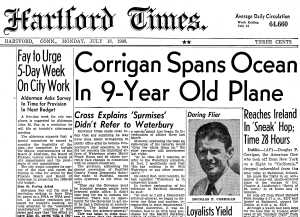Douglas 'Wrong Way' Corrigan
Flew Solo to Ireland in 1938
By Stephen Sherman, Dec. 2007. Updated July 22, 2011.
July 18, 1938 - Corrigan Spans Ocean in 9-year old plane.
Reaches Ireland in 'Sneak' Hop: Time 28 hours.
Douglas P. Corrigan, the American flyer who took off from New York on a flight to California, dropped unheralded from the skies today at Baldonnel, Ireland. He made the flight in an antiquated nine-year-old, single-motored plane of the vintage of Charles Lindbergh's Spirit of St. Louis in 28 hours and 13 minutes.
He took off from Floyd Bennett Field at 5:17 AM, EDT and landed at Baldonnel Airport Dublin, at 9:30 AM EDT. Although a watch had been kept for the lone flier in Ireland after news of his "mystery flight" from New York, its landing here caused the greatest surprise.
Corrigan last year was refused a United States permit to attempt to attempt the hop to Ireland. Nothing had been heard from him since his takeoff. He had no radio, and only the barest of navigating instruments.
Most airmen on this side of the Atlantic had not conceded the daring American much chance of making the Atlantic crossing after reading cabled accounts of his dilapidated craft.
Baldonnel, where he landed in fulfillment of the ambition had nursed for more than a year to fly to Ireland, is the airfield on the outskirts of Dublin.
Because of the Department of Commerce's rejection last year of his application for permission to make such a flight, and because of strict regulations covering such ocean trips, officials at Floyd Bennett field had doubted he would try a sneak hop.
Experienced airmen were astounded today by his unscheduled flight to Ireland in a plane which has few, if any, of the modern aids to flying. The untalkative but agreeable transport pilot had his seat behind bulky gasoline tanks which obstructed his vision to such an extent that he had to bank his 1929 Curtis Robin plane when he wanted to look ahead on his course.
The plane, small and much of similar in equipment and weight to that used by Lindbergh, often was used a decade ago for student training purposes. But those who had the opportunity of seeing Corrigan's plane at the field after his arrival from the West Coast in slightly less than 28 hours flying time said the instrument board contained a couple of magnetic compasses, the conventional bank and turn indicator, and another instrument to indicate climb.
Corrigan was faced with the problem of plotting his course by dead reckoning, a doubly complex problem because he had to fly the airplane while he did his navigation work. Lindbergh used the same system.
Corrigan would have started earlier on what was supposed to have been a flight back to the West Coast, but Kenneth Behr, airport manager, refused to let him take off before daylight. Corrigan had told there he would like to be in his plane, heavily loaded with the gasoline, at 1:00 AM.
Crossed Continent
Corrigan, calmly flew his relic of the Lindbergh heyday from California to New York nonstop in 28 hours more than a week ago. He arrived at Floyd Bennett field without much fuss the night before Howard Hughes took off on his elaborately equipped globe-girdling hegira of less than four days. "Nonstop" fiddled around in the backwash of the Hughes departure and the noisy return of the world flyers, quietly patching up his $900 pride and joy. The slight 31-year-old Californian is respected highly as an airplane mechanic and pilot and is fully licensed by the government to practice his trades.
The government refused, however, his application last year for a license to try a transatlantic flight to Ireland. Strict regulations are in force on such ocean trips and officials at Floyd Bennett field doubted he would attempt a sneak hop.
They pointed out, too, that he carried only one navigation map, both the United States with optional northern and southern roots are cross country chart. His navigating equipment is the simplest: two magnetic compasses, a bank and turn indicator, and an inclinometer.
Corrigan loaded up 320 gallons of gasoline and, as officials breathlessly watched the gas-heavy machine teeter the full length of the runway, took off at 5:17 AM Sunday. The second-hand Curtis Robin is similar in type to the Spirit of St. Louis in which Lindbergh flew to Paris in 1927, now retired to the Smithsonian institution.
Source:
The Hartford Times - July 18, 1938


